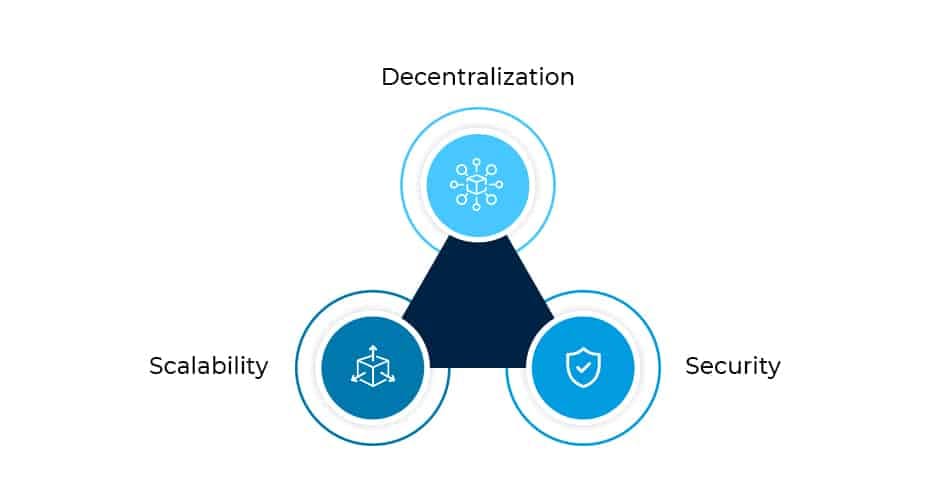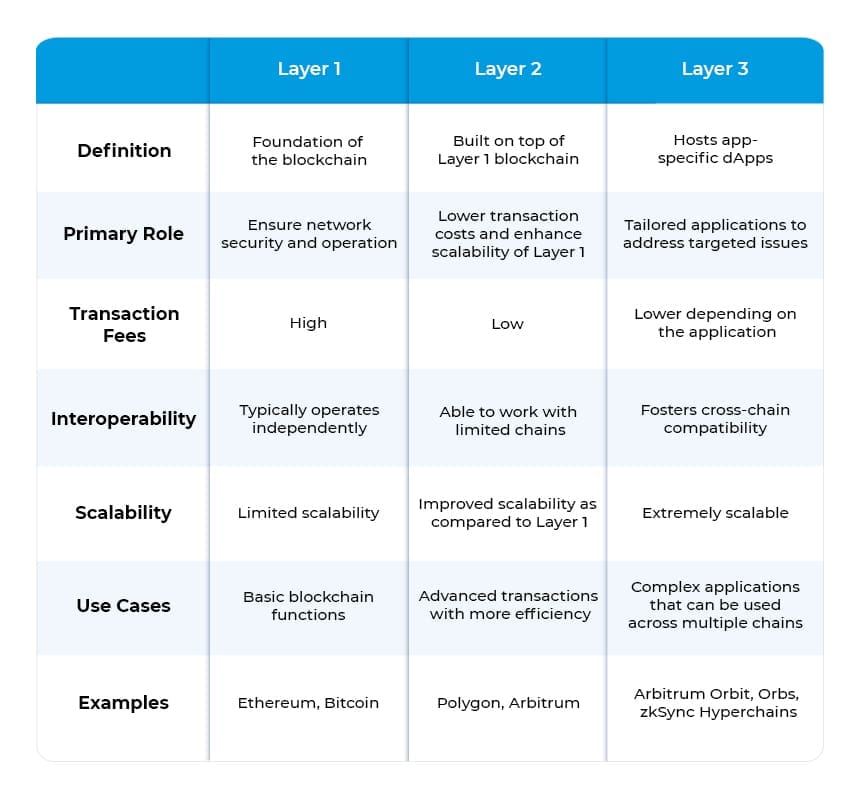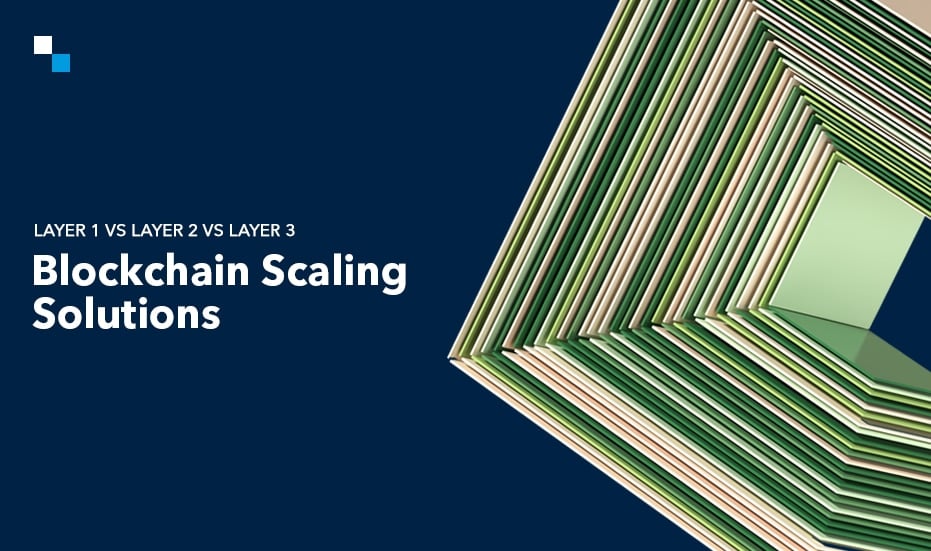Table of Contents
Introduction
Blockchain has become a hot topic in the crypto world because of its irresistible capabilities of decentralization, transparency, security, and immutability. According to Statista, blockchain technology is forecast to increase to nearly 1,000 trillion U.S. dollars by 2032, which indicates an enduring and unstoppable rise in its popularity.
Despite consistently growing blockchain popularity, scalability is one of the most pressing concerns. The incredible increase in the blockchain user base leads to infrastructural bottlenecks in the operations of blockchain networks. This is when the need to address the scalability (a system’s capacity to grow while accommodating increasing demand) issue has become increasingly crucial. The struggle to achieve high throughput is often referred to as Blockchain Trilemma (the balancing act between decentralization, security, and scalability within a blockchain infrastructure).
Fortunately, several blockchain enthusiasts and experts around the world direct their efforts toward building scaling solutions. In this blog, we will delve into the world of blockchain scaling solutions and layer 1 vs layer 2 vs layer 3 blockchain comparison that will help you make an informed decision about which solution best fits your project.
What is Blockchain Trilemma?
The blockchain trilemma, often attributed to Ethereum co-founder Vitalik Buterin, refers to the trade-off between the three critical aspects of blockchain- decentralization, security, and scalability. Achieving one aspect of blockchain might come at the expense of the others.

For example, increasing scalability might require sacrificing some decentralization or security measures, such as using more centralized consensus mechanisms or compromising on the level of node participation. Conversely, enhancing decentralization or security might come at the cost of reduced scalability due to increased overhead or complexity.
Solving the Blockchain Trilemma
Blockchain projects often strive to find a balance among these three properties that align with their specific use cases, goals, and trade-offs. Tweaking in the main layer 1 blockchain, or relying on layer 2 blockchain solutions can address the trilemma by offering ways to improve scalability without sacrificing decentralization or security entirely.
Below, we will delve into the basic understanding of layer 1, 2, and 3 blockchain scaling solutions and how they can help solve the scalability trilemma of blockchain-
Layer 1 Blockchain
A layer 1 blockchain is the base or foundational layer of a decentralized cryptocurrency network. This base layer is responsible for validating transactions, maintaining the distributed ledger, and securing the network from malicious attacks, through a common consensus mechanism such as proof of work (PoW) and proof of stake (PoF). Some of the examples of layer 1 blockchain solutions include Ethereum, Bitcoin, and Cardano.
List of Layer 1 Blockchains
- Ethereum 2.0
- Solana (SOL)
- Cosmos (ATOM)
- Avalanche (AVAX)
- Near (NEAR)
- Polkadot (DOT)
- Cardano (ADA)
- Algorand (ALGO)
- Tezos (XTZ)
- Tron (TRX)
Read – The Ultimate Layer 1 Blockchain List to Keep an Eye on in 2024
Scalability Solutions
Each layer 1 blockchain solution has to either develop or adopt scaling solutions to handle higher transaction volumes to stay competitive in the long run. These include-.
- Chain Fork
Forking a chain refers to upgrading the chain with new features or adjusting it. Forking can be either soft or hard. Soft fork refers to new infrastructure changes that maintain compatibility with the old nature of the chain. Hard forks, on the other hand, are the new changes made using different modes of operations from those of the previous chain. Bitcoin is one of the blockchain networks that conducted a soft fork to achieve scalability. This soft fork has improved the Bitcoin blockchain network’s performance, increasing its processing load from 1600 transactions in a block to almost 3000.
- Consensus Mechanism
It is important to note that some consensus mechanisms, for instance, proof-of-work, are not as efficient as layer 1 blockchain scaling solutions. Ethereum is a perfect example of it, which moved from proof-of-work to proof-of-stake. The former mechanism allowed it to process 10 transactions per second. However, the later, proof-of-stake mechanism increased Ethereum’s data processing load to around 32 blocks. When it comes to stability, Ethereum has a long way to go, however, the switch to the PoS is a strategic move towards the goal.
- Sharding
Sharding is a renowned scaling technique that involves partitioning the state of a blockchain network into smaller, faster, more easily managed pieces. These smaller parts are often referred to as data shards. Only the nodes in an individual bit process transactions which is efficient and requires less time than all the nodes on a blockchain protocol required to agree. Although no layer 1 blockchain has successfully implemented this technique, it is still a concept that is gaining the attention of the major layer 1 blockchain like Ethereum.

Layer 2 Blockchain
Layer 2 blockchain refers to the layer on the top of the layer 1 solution. Layer 2 protocol utilizes the layer 1 blockchain solutions for security and network infrastructure, however, it is more flexible when it comes to scaling the transaction processing and throughput on the network. Some layer 2 blockchain solutions examples include Bitcoin’s Lightning Network and Polygon (layers on top of Ethereum).
List of Layer 2 Blockchain and Scaling Solutions
- Polygon
- Arbitrum
- OP Mainnet
- Avalanche Subnets
- Loopring
- Starknet
- Eclipse
- Hyperchains
- Immutable zkEVM
- SKALE
Read – Top 10 Layer 2 Blockchain Solutions in 2024 to Supercharge Your Blockchain Scalability
Scalability Solutions
- Rollups
Rollups are layer 2 blockchain solutions that bundle multiple transactions into a single batch and submit them to the main blockchain for validation. Rollups significantly reduce transaction fees and increase throughput by aggregating transactions off-chain and submitting compressed data to the main chain. Optimistic rollups and zk-rollups are two variants of this approach, that are popular for their unique trade-offs between scalability and security.
- Sidechains
A side chain is one of the layer 2 blockchain scaling solutions that operates alongside a main chain to optimize its performance. When transactions are initiated on the main chain, assets are temporarily locked while the sidechain processes them. Most sidechains often rely on an independent third party to check the anomalies in the activities between the mainnet and sidechain. Although sidechains function independently, they still rely on the security of the main chain. However, it’s important to note that any security breaches on a sidechain do not affect the main chain.
- State Channels
Layer 2 blockchain solutions networks also utilize state channel scaling mechanisms that are highly applauded for their unparalleled privacy and speed. With state channels, some of the portions that would usually be done on the main blockchain are moved to a special wallet outside of the blockchain. Participants using these state channels can do things like send money directly to each other without needing to involve the usual miners who validate transactions. When they’re finished with their transactions, the final results are added back into the main blockchain. State channels are seen as one of the best ways to make blockchains faster.
- Nested Blockchain
Nesting is a layer 2 scaling solution in which a blockchain protocol houses other blockchains within or on top. The nested chain starts with a parent chain followed by child chains. Whenever the transaction is processed, the parent chain will give some of its work to child chains that execute the transactions and send the result to the parent. Once the main chain finishes processing transactions, it shares the results with the layer 1 blockchain. Ethereum Plasma is one of the popular examples of a nested blockchain protocol on Ethereum that has a relatively fast transaction capacity of 5,000 TPS.
Layer 3 Blockchain
Layer 3 blockchain is a highly customizable blockchain built on top of layer 2s to offer maximum scalability, interoperability, and application-specific functionalities. Layer 3 blockchains solutions allow a developer to create customized blockchains based on their needs. Currently, most layer 3 blockchain solutions are built on Ethereum. However, some blockchains, such as Bitcoin are not suited to host layer 3 applications at the time of writing.
List of Layer 3 Protocols
- Cosmos (IBC Protocol)
- Polkadot
- Chainlink
- Degen Chain
- Arbitrum Orbit
- Superchain
- Orbs
- zkHyperchains
Layer 1 vs Layer 2 vs Layer 3 Blockchain- A Comparison

Key Differences
Definition
- Layer 1 blockchain refers to the core infrastructure of a blockchain network that forms the foundation. It is also known as mainnet, where blocks are added and transactions are finalized.
- Layer 2 blockchains are off-chain vertical scaling solutions that build upon the foundation of Layer 1 blockchains by introducing an additional layer to enhance scalability.
- Layer 3 blockchains are advanced protocols that are built upon existing Layer 2 blockchain solutions and offer interoperability and application-specific functionalities.
Scalability
- Layer 1 achieves scalability blockchains, utilizing scaling mechanisms such as utilize methods such as changing the consensus mechanism, forking the chain, and sharding.
- Layer 2 blockchains solutions exist as nested blockchains, rollups, state channels, and sidechains, improving their scalability as compared to L1.
- Talking about layer 3 blockchains solutions, it work beyond the current capabilities of layer 1 and layer 2. Layer 3 network is able handle to a larger volume of transactions and support a wide range of complex applications at a time.
Interoperability
- Interoperability features in layer 1 blockchain solutions are often limited to compatibility with other blockchains through standardized protocols or bridges. Direct communication between disparate networks may be challenging to achieve at this layer.
- Layer 2 blockchain solutions primarily focus on enhancing scalability and may not inherently provide interoperability features. However, interoperability can be achieved indirectly through layer 2 protocols that interact with multiple blockchains.
- Interoperability is a core feature of layer 3 blockchain solutions, which are specifically designed to facilitate communication between different blockchain networks. These solutions enable seamless data transfer and asset exchange across various platforms, fostering a more interconnected ecosystem.
Transaction Fees
- Transaction fees on layer 1 blockchain solutions can vary depending on network congestion and protocol design. In general, fees may be higher due to limited on-chain capacity and increased competition for block space.
- Layer 2 blockchain solutions typically offer lower transaction fees compared to Layer 1, as many transactions are processed off-chain without incurring the same level of congestion or resource consumption.
- Transaction fees in layer 3 blockchain solutions may vary depending on the specific protocols and networks involved. However, by enabling cross-chain transactions, layer 3 blockchain solutions offer users access to a wider range of options for optimizing transaction costs.
Conclusion
In conclusion, layer 1, layer 2, and layer 3 blockchain solutions offer their own set of advantages and challenges. It makes it crucial for developers and stakeholders to carefully evaluate their specific needs and priorities when choosing a scaling solution.
Layer 1 solutions like sharding and protocol upgrades aim to improve blockchain scalability at its core, while layer 2 blockchain solutions, such as sidechains and state channels provide off-chain methods to alleviate congestion and increase transaction throughput. Layer 3 solutions, focusing on interoperability and cross-chain communication, offer promising avenues for enhancing scalability across multiple blockchain networks. Ultimately, the success of any scaling solution will depend on its ability to strike a balance between scalability, security, decentralization, and usability, driving forward the evolution of blockchain technology toward greater efficiency and adoption.
With Antier’s blockchain development company’s assistance, you will not only be able to understand the difference between layer 1 vs layer 2 vs layer 3 blockchain, but also leverage its power for your project. We have specialized blockchain experts who can work on your project and deliver the best blockchain solution you deserve.







